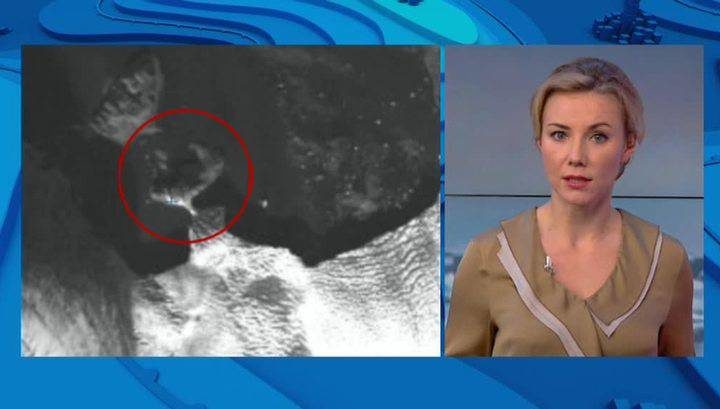The following clip taken from Russian nightly news with a transcript below gives the details a new island discovered by two young Russian students recently.
And now let's visit the Arctic. A new island has been discovered near the archipelago of Novaya Zemlya. The discovery was made by 2 students from the Moscow region: Artyom Makarenko and Valeriy Sayenko. The documents required to register the new geographic location were submitted to the Russian Geographical Society.
Ekaterina Grigorova will explain how the discovery was made.
- Ekaterina, good morning. Where was the newly discovered island hiding?
- It was hidden under the ice, and now the ice in the Arctic is melting rapidly, revealing new areas. The students used images from the Russian satellite Kanopus-V and the European satellites Landsat and Sentinel to study the Arctic glaciers. According to the monitoring data, the island appeared in December 2017 as a result of the retreat of the front part of the Vilkitsky glacier and the collapse of the ice bridge that connected the island to the glacier.
The newly discovered island is not large, the overall area is around 19 hectares. This discovery testifies to the accelerated rate of glacier degradation in Novaya Zemlya.
The Novaya Zemlya archipelago is essentially a mountain range flooded by the sea. It consists of several parallel ranges, reaching a maximum height of up to 1.5 kilometers in the north. The total glaciation area is 24,400 square kilometers. The glaciation occurred due to the fact that the archipelago is located in high latitudes and that it gets cyclones from the North Atlantic regions, which carry heavy precipitation with them. There are small mountain glaciers in the south, which turn into solid ice cover up north.
According to the latest estimates, in the period between 1952 to 2012, the area of the mountain glaciers in Novaya Zemlya was reduced by 150 square kilometers. In total, the archipelago lost 580 square kilometers of glaciated area, or 2.5% of the entire glaciated area within the same period.
One of the possible reasons for that is that the route of the cyclones, which carry humidity and precipitation from Iceland, has shifted northward. The archipelago encounters warm air currents more often. The chart shows how the average annual temperatures have changed over the last 50 years.
That's the data gathered by the Arctic weather station Malye Karmakuly. Before the start of the 21st century, the average annual temperature was around -5°C. In the period between 2003 and 2017, it increased to -2.3°C. 2016 was the warmest year, with an average annual temperature of -0.2°C.
Comment: That time period is relatively short and recent, and the overall trend is one of cooling - that's not to say some areas aren't experiencing fluctuations.
It seems that global warming has helped discover the new island. In December 2017, the retreating glacier revealed one of the rocks hidden under the ice. Then the ice bridge that connected the rock to the glacier collapsed, thus forming the island. This image, made by the Sentinel satellite, shows the first radar image of the island without the ice bridge. Now the strait between the island and the glacier edge is getting bigger. That's how the island at Wiese glacier appeared last year.
relates back to
The analysis of the glacier shadows helped discover a rock ledge, which could also turn into a new island in the years to come.
So, Andrei, we'll be expecting some discoveries.- Yes, we will. Thank you.
Comment: Clearly there are great shifts occurring to our climate and the greatest driver we're seeing on our planet, and others, is the grand solar minimum. These effects are evident in the jet stream which is drifting further south resulting in the polar vortex and sudden stratospheric warming phenomenon and the slowing gulf stream, all of which could be contributing to the increasingly unusual weather patterns and the obvious cooling trend around the globe. This discovery could also be related to the other geological anomalies we're seeing in the form of sinkholes, landslides and earthquakes:
- 'Sinking' Pacific Island is actually growing
- Sandy beach that 'vanished' 12 years ago in freak storm suddenly returns overnight in Mayo, Ireland
- New island forms off northwest England
- 8 dead as massive sinkhole swallows eight-lane road in Foshan, China (PHOTOS, VIDEO)
- GARGANTUAN sinkhole swallows several cars and building is evacuated in Rome (VIDEO)
- UK: 'Very unusual' sinkhole on train tracks after Storm Eleanor, 'ground shifting' say engineers
- Venice water levels lowest since records began - and it's sinking (PHOTOS)




Reader Comments
to our Newsletter